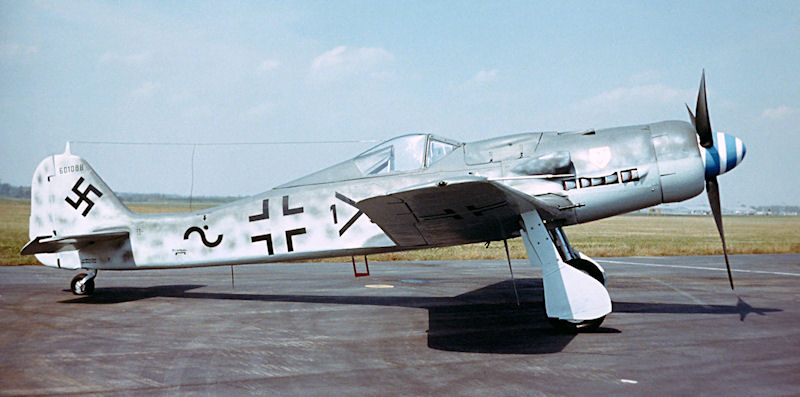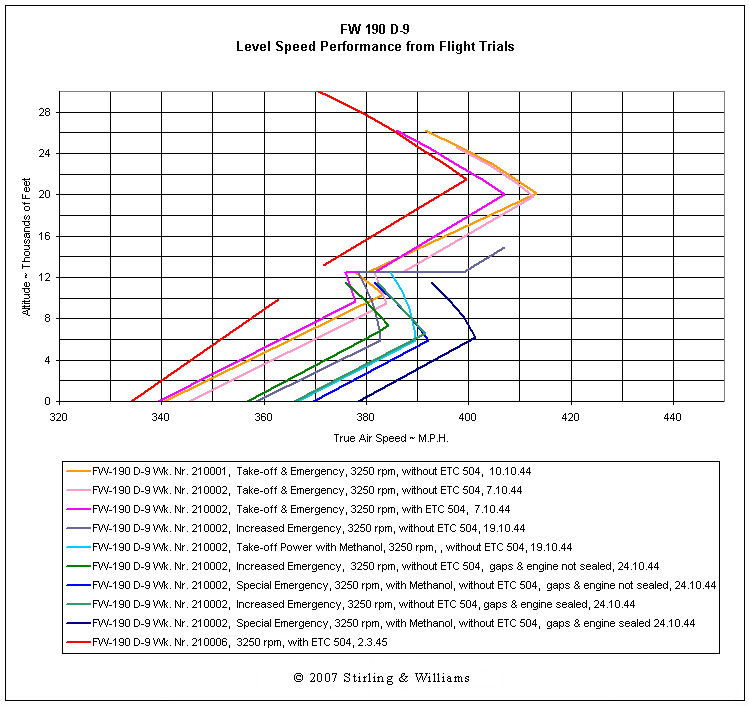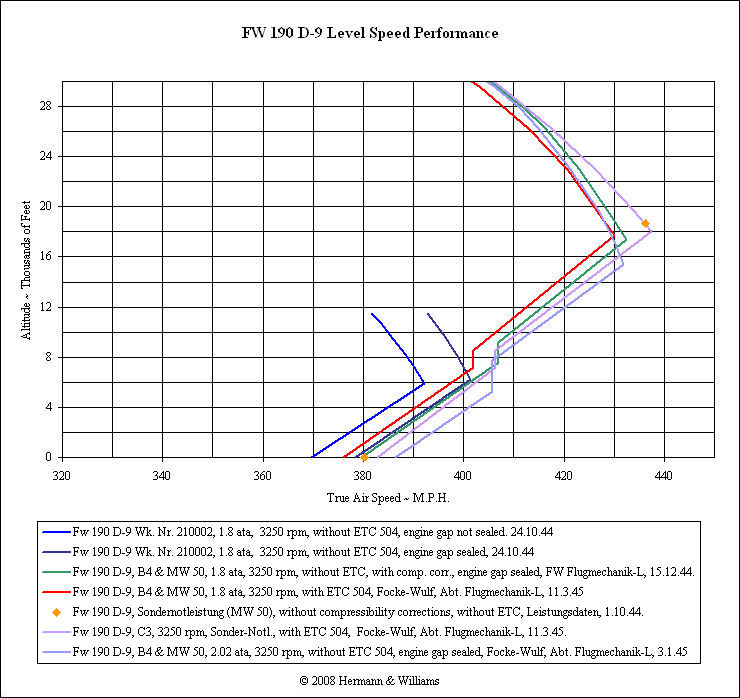

 | Flight Report Fw 190/170003 V 53 Nr. 1 | S.O.Archiv Bad Eilsen |
|
 | Flight Report FW 190 D-9/210001 Nr. 1 | S.O.Archiv Bad Eilsen |
|
 | Flight Report FW 190 D-9/210001 Nr. 2 | S.O.Archiv Bad Eilsen |
|
 | Flight Report FW 190 D-9/210001 Nr. 3 | S.O.Archiv Bad Eilsen |
|
 | Flight Report FW 190 D-9/210002 Nr. 1 | S.O.Archiv Bad Eilsen |
|
 | Flight Report FW 190 D-9/210002 Nr. 2 | S.O.Archiv Bad Eilsen |
|
 | Flight Report FW 190 D-9/210002 Nr. 3 | S.O.Archiv Bad Eilsen |
|
 | Flight Report FW 190 D-9/210002 Nr. 4 | S.O.Archiv Bad Eilsen |
|
| E-Stelle Rechlin | Flight Performance Fw 190 D-9 with Jumo 213 A. | Erpr. Nr.9003 Teilber.2. |
|
Flight performance of the Fw. 190 D-9 (production version) is given. Speed at altitude was flown with Serial Nr. 006. Various aircraft were checked at 3,000 rpm during continuous testing. Speeds reached 323 to 329 mph (520 to 530 km/h) at sea level and 388 to 395 mph (625 and 635km/h) at 21,325 ft (6.5 km) (about full throttle height, depending on engine adjustment). With 3250 rpm, speeds reached 335 to 342 (540 and 550 km/h) at sea level and 401 to 407 mph (645 and 655 km/h) at 21,653 feet (6.6 km). With 3250 rpm and a take-off weight of 9,480 lbs (4,300 kg), rate of climb was 3,329 ft/min (17.0 m/s) at sea level and 392 ft/min (2.0 m/s) at 33,465 feet (10.2 km). I. General information.
Aircraft condition:
II. Performance tests. Speeds were ascertained from dynamic pressure tests. Calibrated measuring instruments were used.
The interesting Va-area was reached by flight measuring on the test range.
III. Results of the tests. The results are on graphs 5 to 9. The level speeds were reached with different engine rpms. It is remarkable that speeds were around 9 mph (15 km/h) higher in the past with Serial Nr. 006 at 3000 rpm (see report of 15.11.44). The current speeds were reached after installation of a new engine, correct engine adjustment, and with the standard propeller. Performance shown in the report of 15.11.44 was determined, through continuous testing, with an unadjusted engine and a D-12 propeller. The speed loss is therefore from engine and propeller differences (D 9 and D 12 propeller). 1.) Level Speeds. They are shown on sheet 5 and apply to a nominal weight of 9,259 lbs. (4200 kg). The V curves are drawn in throughout the entire speed range, so that one can read off the associated Va at each height to each Vw. Sheet 6 shows the dependence of the airspeed on the flying weight and sheet 7 the influence of a 66 gallon (300 l) external tank on the speed. Example: Search: Speed at 26,246 feet with a weight of 9,700 lbs, 66 gallon drop tank height, and 2300 rpm.
The final Va = 380 km/h is registered on sheet 5 (H = 6 km.) Point V and perpendicularly under V on H = 0 km, in the example looked for Vw = 506 km/h read off, point VI. 2.) Climb performance. It is shown on sheet 8 for 3000 rpm and 3250 rpm
3.) Radiator flap test flight. The influence of the radiator flap position on speed (with empty drop tank) was determined at 6,562 feet with 2700 rpm, (see sheet 7, Fig.e). The entire opening was divided into 10 equal parts, "0 = completely down" and "10 = completely up". The test shows that the speeds are greatest with a 2,3 radiator flap position (approx. flush), i.e. the speed loss is lowest. If possible, level flight should be flown at this position. |

|
Lutz Naudet placed these performance trials in context:
The following chart depicts level speed performance as calculated by Focke-Wulf along with the results presented in Report 3 of Wk Nr. 210002. 
For metric verison of above the chart see Here The condition representative of standard production Fw 190 D-9’s during 1945 is as follows: Jumo 213A operating at 1.8 ata with B4 fuel & MW 50, equipped with ETC 504, main wheel fairing doors absent/fixed and engine gap not sealed. Of all the data charted in the compilation curve linked above, that curve best fitting the condition of a standard production Fw 190 D-9 is curve 4 of the Focke-Wulf Fw 190 D-9 chart dated 11.3.45 (the red line). One shortcoming of this curve, when viewed in context with other curves from Focke Wulf’s Flugmechanik Department, is that it assumes the installation of the engine gap seal and is therefore approximately 13 km/h optimistic relative to the condition of delivered production aircraft (with rack minus the drop tank). Dietmar Hermann summarized FW 190 D-9 performance as follows: I haven’t read or heard that the D-9 was tested with the Jumo 213 and C3 fuel. I know that at the beginning of development Focke-Wulf made a distinction between the normal Jumo 213 and the Jumo 213 with 100 octane fuel. I think that there was not a problem with the engine; rather there was a problem of the fuel’s availability. In my book I have published one chart from 3.1.45 (page 154) showing FW 190 D-9 performance with B4 fuel with MW 50 injection operating at 2,02 ata (Sondernotleistung ). However, I have no evidence showing that 2,02 ata was enabled by the end of the war. I think that the D-9 was flown either with the 1900 PS update or with MW50 injection (2100 PS). Hermann wrote of testing the Fw 190 D-9 in his book Focke-Wulf Fw 190 "Long Nose": In the beginning only the Fw 190 V17/U1 and Fw 190 V53 prototypes were available for extensive flight testing. The V53 was used for performance trials at Lanenhagen. For the most part these confirmed the estimated performance figures. The V53's armament initially consisted of two MG 131 machine-guns in the fuselage, two MG 151 cannon in the wing roots and two MG 151s in the outer wings. This was the armament originally planned for the production D-9s. The outer wing cannon were later removed. The V53 was painted in a standard camouflage finish. At a gross weight of 4070 kg with ETC 503 external stored rack, the V53 achieved 555 km/h at ground level at 3,250 rpm (emergency power). During flight trials the V53 was involved in a heavy forced landing. It was subsequently repaired, but for safety reasons it was limited to low-level flights. Hermann noted the following points regarding the Fw 190D-9's operational history: The first thirty production aircraft were delivered to the unit (III./JG 54) at the beginning of October 1944. * Dietmar Hermann, Focke-Wulf Fw 190 "Long Nose", (Schiffer, Atglen, PA, 2003) Donald Caldwell wrote of the FW 190 D-9’s operational debut in his The JG 26 War Diary Volume Two 1943-1945 (pages 388 – 399):
|
Flugzeugbestand und Bewegungsmeldungen
| Actual Strength First of the Month |
Incoming |
Outgoing |
Actual Strength Last of Month |
|||||||||
| Date | Number | Model | Total | New Production |
Repaired | From Other Units | Total | Enemy Action | Other Causes | Overhaul | To Other Units | Number |
| Stab/JG2 | ||||||||||||
| 11.44 | 0 | Fw 190D-9 | 1 | 1 | - | - | - | - | - | - | - | 1 |
| 12.44 | 1 | Fw 190D-9 | 3 | 2 | - | 1 | - | - | - | - | - | 4 |
| I./JG2 | ||||||||||||
| 12.44 | 0 | Fw 190D-9 | 54 | 54 | - | - | 16 | 3 | 11 | 1 | 1 | 38 |
| III./JG2 | ||||||||||||
| 12.44 | 0 | Fw 190D-9 | 2 | 2 | - | - | - | - | - | - | - | 2 |
| Stab/JG26 | ||||||||||||
| 12.44 | 0 | Fw 190D-9 | 1 | 1 | - | - | - | - | - | - | - | 1 |
| I./JG26 | ||||||||||||
| 12.44 | 0 | Fw 190D-9 | 63 | 62 | 1 | - | 14 | 9 | 5 | - | - | 49 |
| II./JG26 | ||||||||||||
| 11.44 | 0 | Fw 190D-9 | 55 | 55 | - | - | - | - | - | - | - | 55 |
| 12.44 | 55 | Fw 190D-9 | 11 | 11 | - | - | 27 | 9 | 15 | 3 | - | 39 |
| III./JG26 | ||||||||||||
| 12.44 | 0 | Fw 190D-9 | 5 | 5 | - | - | 4 | - | - | - | 4 | 1 |
| III./JG54 | ||||||||||||
| 9.44 | 0 | Fw 190D-9 | 18 | 18 | - | - | - | - | - | - | - | 18 |
| 10.44 | 18 | Fw 190D-9 | 46 | 45 | 1 | - | 8 | 6 | 2 | - | - | 56 |
| 11.44 | 56 | Fw 190D-9 | 22 | 20 | 2 | - | 10 | 2 | 7 | 1 | - | 68 |
| 12.44 | 68 | Fw 190D-9 | 7 | 4 | 3 | - | 26 | 21 | 5 | - | - | 49 |
| As of 31 December 1944 there were 183 FW 190 D-9's on strength with operational units. On 1 January 1945 at least 64 Fw 190 D-9's from JG 2, JG 26 and JG 54 were lost during Operation Bodenplatte. It was recorded by the Gen.Qu. that as of 10/11 April 1945, JG 2 and JG 26 taken together had 138 FW 190's on strength of which 70 were serviceable. |
Special thanks to Dietmar Hermann for his invaluable assistance. Thanks also to Bryan Bury, Lutz Naudet, and Henning Ruch.
[Main] [German version of this page] [Material Command Report on FW-190 D-9 FE-121]
© 2008 WWIIaircraftperformance.org. All Rights Reserved